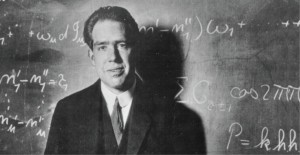The ‘Bohr atom’, or more properly, Neils Bohr’s model of the hydrogen atom, was announced to the world 100 years ago. A hydrogen atom contains only one proton and one electron, but its internal structure was a mystery to scientists. Why didn’t the negatively charged electron ‘fall into’ the positively charge nucleus? Why did excited hydrogen atoms emit radiation of specific colors (wavelengths) and not others? Neils Bohr explained it all. And while his model was replaced in the mid-20’s by Schrodinger’s wave formulation, many of his discoveries have stuck around as basic concepts in science:
- the idea of ‘stationary states’ in which atoms (or molecules) can exist in a state of defined energy and then undergo a transition to a state of higher (or lower) energy
- ΔE = hν, the connection between changes in energy state and radiation frequency
- R, the ‘Rydberg constant’, = 2π2me4/h3
To read a bit more about Bohr’s discovery, check out “100 Years of Atomic Theory” by David C. Clary (Science, 19 July 2013, p. 244, DOI: 10.1126/science.1240200). There’s also an author interview (podcast).

